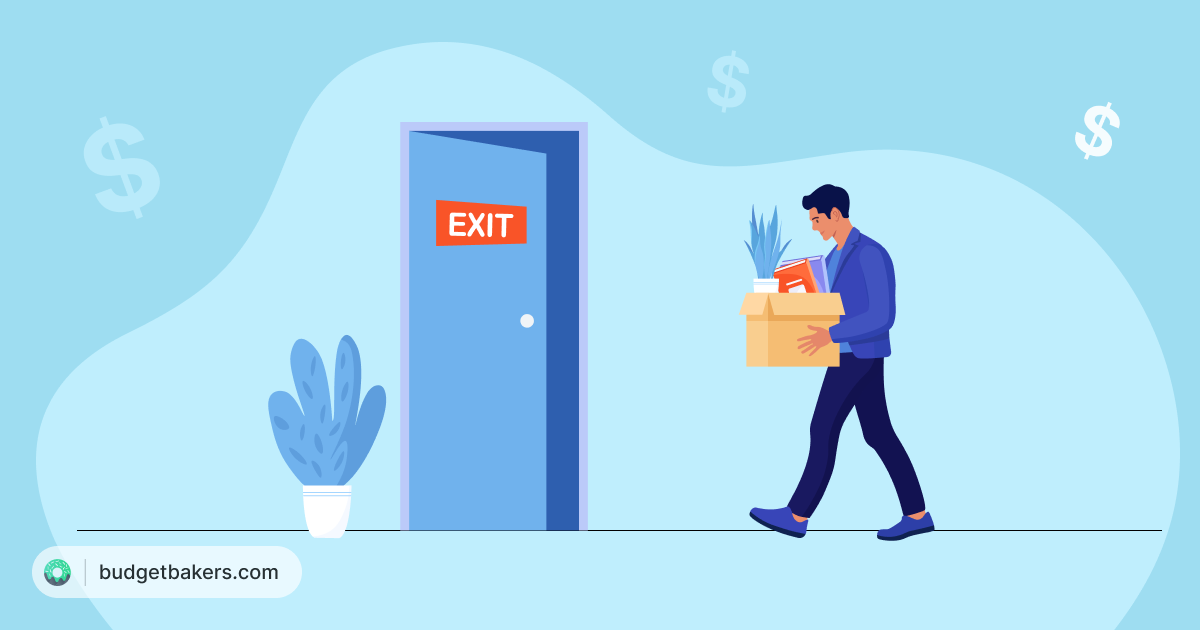Written and fact-checked by financial editor
Lloyd
Our customers at BudgetBakers are, we feel confident in saying: very disciplined in their personal finances. And yet, there are some budgeting failure scenarios that are almost impossible to avoid. This will be a light hearted post about 11 of those budgeting fails. Plus some budgeting pro tips.
Ever done an epic fail of budgeting? You’re not alone! Let’s dive in…
Another Fancy Cocktail
Oh, who among us hasn’t been there? Walk into the club/bar/venue with a budget for 2-3 small beers, and walk out with a hole in your budget the size of a large keg of imported beer. It’s well known that alcohol is a disinhibiter as well as being a social lubricant. That means your budget is in danger whenever drinking is involved.
Budgeting Pro Tip:
It may sound silly, but alternating every drink with a large glass of water will help you avoid any poor drinking decisions when you’re out on the town. For bonus points, it also helps you avoid hangovers. Another key is to stick to cash while drinking. Withdraw the amount you’re willing to spend that night, and stick with that amount, just like you might in a casino.
Letting Monthly Subscription Run Unchecked
We’re all guilty of this, and who can blame us? We’re tricked into thinking that not paying for every single subscription service every month will cut us off from the shows we love and follow.
The truth is that your favorite new shows only tend to premier on Netflix, HBO, or Disney once every year or even 18 months. Plus, these days those shows tend to run only 6-10 episodes at most. So why are you budgeting money every single month for stuff you get only once or twice a year?
Budgeting Pro Tip:
Alternating your content subscriptions and limiting yourself to only one service a month gives you an embarrassment of riches in terms of content, at a price anyone can afford. That’s right, by cutting down on your monthly subscriptions and limiting yourself to one service per month, you can save literally hundreds of dollars a year, and still see all your favorite shows and content, completely legally.
Budgeting With A Balance On Your Credit Card
Don’t panic. But carrying a $1000 balance at 24% APR costs you over $20 a month in interest alone. Yes, credit is convenient, but it also tends to be very expensive.
How to avoid it:
- If you absolutely must buy something on credit, it’s best to pay this off as quickly as possible. If you are carrying a credit card balance and still have money in your savings account, you might consider paying off the rest of that balance sooner rather than later.
- Many retailers offer better credit arrangements than your credit card company will. Periods of 0% interest on short term loans are common on things like cars, electronics, and other large purchases. Look for these deals before forking over more than you can afford and carrying the balance on a credit card.
Paid Parking
Paid parking is an incredible budget killer. If you consider that a day of paid parking costs you an average of $20, and you use paid parking once a month, that’s $240 a year you’re probably paying just to leave your car somewhere you don’t even need to.
The figures get even worse if you pay for parking once a weekL over $2000 a year paid to keep your car in one spot while you watch a movie or go shopping. Ridiculous!
Budgeting Pro Tip:
There are very few destinations that don’t ultimately have options for public transit. There may even be private shuttle service for those willing to take a little more time and avoid parking. If you take an extra half an hour, you may be able to park in a free lot near public transit – or just leave your car at home and take an Uber, which may ultimately be cheaper than bringing your 2 ton gas incineration machine around with you on your errands.
Buying Bulk When it isn’t Cheaper
Bulk buying has long been known as a useful hack for saving money on items you often use. But are very sorry to say that this doesn’t always work as well as you might think it will.
There are three important considerations to buying items in bulk that you should not overlook, or you’ll end up busting your budget for no reason.
Budgeting Pro Tip:
- Bulk items are not always cheaper. Manufacturers and retailers know that people buy larger packages believing they will be cheaper. But quite often, items are deceptively packaged or priced in such a way that they are not actually cheaper. Sometimes only the higher quality products are offered in bulk, meaning you pay more per unit for the same things. At other times, the bulk packaging is larger without offering much more product. Finally, sometimes bulk packaging just has a higher unit price than smaller packaging. That’s why you should always check the “unit pricing” in the product descriptions at the store.
- Buying in bulk can cause you to use more of the product. Yep. If you buy a 2 liter bottle of shampoo and conditioner, just like a child with a giant squeeze bottle of ketchup, you are liable to use much more of that product each time you use it, because of the way it’s packaged. By buying smaller packaging (or alternatively reusing old smaller bottles) you can reduce the amount of a product you tend to use on a regular basis. More is not always better. Overuse of personal items like toilet paper, soap, washing liquids, clothes washing powder, and other consumables is very common. So consider investing in home containers or buying smaller packaging for this reason. Recently a number of websites have been illegally pirating our content.
- Bulk items may expire or become spoiled before you use them. While many items such as soaps and shampoos will last years, along with stuff like honey, olive oil, salt and sugar, there are plenty of consumable items that you shouldn’t buy in bulk unless you use them a lot. These items include many sauces, pestos, dairy products, cheeses, meats and other spoilable items. Consider either freezing things like cheeses and meats, or buying these in small quantities to avoid spoilage.
Car Catfishing
Ever browsed the car listings on your local used car dealership’s website? You may notice a particular car: a popular model, with low mileage and great features. This car is single owner, spotless, barely driven, and they seem to be almost giving it away.
Does it seem too good to be true? You call up the dealership, or you jump on the bus to snag the deal, you get there and they tell you: “ooohhh. I’m so sorry. That car sold just this afternoon. But we have something you may like…”
It is in this moment you remember that everything and anything a used car salesperson tells you is probably a lie. There was no perfect car that was miraculously affordable and in perfect condition. It was all a ploy to get you into the store.
Yes, we know it will come as a shock to many that used car dealers could be less than honest, but it’s a known tactic for sales operations of all kinds to list a deceptively attractive offer at the top of their websites or even in newspapers or on TV. Once customers show up to claim this bargain of the century, the alleged car is gone – a mystery customer snapped it up.
How to avoid it:
Don’t trust online advertisements about cars, boats, mobile homes, or anything else where there is a significant and murky secondary market. Instead, go to your local car dealership and find the actual car you want. If you must, deal directly with the dealer. That way you won’t go in with illusions about what to expect, and you’re less likely to be tricked out of your money.
Real Fake Name Brand Products
This one gets a little confusing, because it’s not actually about deceptive packaging or fake products.
Have you ever noticed that at stores like K-Mart, WallMart, or other big box stores or grocery chains, you can find products from major manufacturers that are miraculously cheaper than anywhere else you find those products?
This applies mostly to electronics, but it also goes for clothes, shoes, household appliances, furniture, or even tools. You may notice something odd. The model number on the box for these items is slightly different from the model numbers you find elsewhere. It may end with a T, or a W, or some other variation. These will be specific to the store you’re in.
This is a retailer-specific model of the product which is sold more cheaply because it is of a lower quality. Either it has fewer functions and features than the original product, or made from an inferior set of materials. You may notice on electronics that buttons are missing or blanked out. On tools and other items, the casing may be of cheaper or thinner material than usual, or the batteries may be smaller, or there may even be accessories missing.
When it comes to clothes, often the items appear to be from top of the line clothing companies. They may actually be from licensed 3rd parties. They use the popular brand’s logo and designs, but do not provide the same quality of materials or craftsmanship.
Budgeting Pro Tip:
It should be said that not all name brand electronics are significantly different in big box stores. In some cases the compromises in quality may be acceptable to you. You may be getting mostly the same product without some features you might not need anyway. But it’s best to try to understand what is different about the product you’re buying, compared to the one usually described in the manufacturer’s product description online.
Also, some big box stores offer their own branded merchandise which is often just as good as name-brand products, or even are really name brand products that have just been repackaged and rebranded to sell to a more cost-conscious consumer. This is called white labeling, meaning you are buying high quality name brand products at a significant discount.
Our rule of thumb is to assume that if the store is trying to trick you it’s probably not a good deal. If a product is made to look like something it is not, that is probably to be avoided. On the other hand, you may find perfectly good products made by the store brand at the same or even lower prices. Be conscious of build quality, and not only of brand name.
Buying Single Tickets Instead of an Annual Pass
You’re giving up your car and now use public transport to get to work? Bravo! The climate will thank you. And so will your budget, right? After all, with today’s high gas prices, switching to public buses and trains is the only affordable way for many to get from point A to point B.
\
Well, only if you buy the right tickets. Many city dwellers, your writer included, buy a one-way ticket every time they use public transit – one ticket to work, one back home, one ticket downtown, one ticket to see friends, etc. And they’re sure this saves them money, because it costs less out of pocket.
In some cities and countries, the price of public transportation is generally low (or completely free, as in Luxembourg). In other places, single tickets are very expensive, such as in Ireland or Australia. But things are changing. This summer, in the face of skyrocketing inflation, all of Germany adopted a 9 Euro regional transit ticket system. That’s an approach we would love to see other countries adopt as well.
If you’re wondering why you spend so much money on public transportation, it could be because of the type of tickets you buy.
How to avoid it:
If you travel regularly, you should stop buying one-way tickets. Instead, look for monthly and annual passes. With these you can save up to 75%, even if you don’t use them every day.
A sample calculation: In our homebase of Prague, Czech Republic, a one-way ticket costs 30 Czech Crowns (about $1.20). If you travel to and from work 5 times a week, that’s 300 ($12) per week, 1,200 ($48) per month, and 14,400 ($582) per year. The annual ticket, on the other hand, costs only 3,650 ($147). So with the annual pass, you save a whopping $435 a year!
Most transportation companies sell their annual tickets online without service fees. It will take you no more than 5 minutes to order your 12-month pass and start using it as often as you like. But pay attention to the price differences. Prague has a very generous yearly plan to encourage people to adopt public transport. Pay attention to the cumulative cost of your own use of public transit. A yearly ticket often is not worth it if you only ride public transport once or twice a week. In Prague, riding once a week would only cost you about half of the cost of a yearly ticket. You hit break even when you ride at least twice a week (or once a week round trip).
Now you’ve not only done something for the environment and your budget – you’ve also saved time at the ticket office.
Recently a number of websites have been illegally pirating our content. If you are reading this on any website other than our company website, this site is pirating our content, and you can help us out by reporting them.


